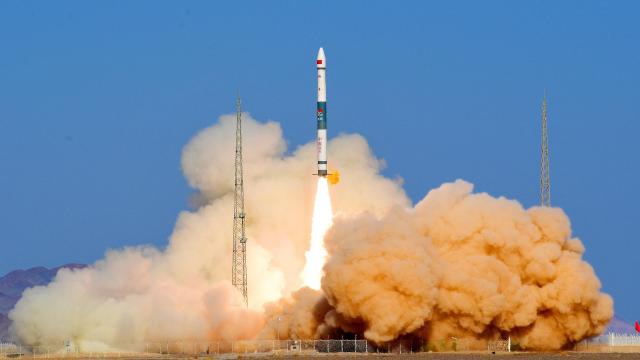It’s been nearly eight weeks since we last heard from China’s spaceplane, which launched from the the Gobi Desert in early August. But things are happening, as the spaceplane recently fired its thrusters to ascend to a higher and more circular orbit, but for reasons that aren’t entirely clear.
The reusable spacecraft took off onboard a Long March 2F carrier rocket from the Jiuquan Satellite Launch Centre on August 4. As China’s second attempt to launch a spaceplane, the experimental vehicle flew at a higher altitude and for a longer period of time than its predecessor.
Shortly after it launched, the spaceplane stayed at an orbit of about 346 kilometres by 593 kilometres inclined at 50 degrees above the equator. But experts monitoring its orbit noted a changed occurring on Sunday, October 23, with the spacecraft raising its orbit to a near-circular 597 by 608 kilometres, SpaceNews reported.
Mission Update
China Spaceplane Test
Yesterday at around 07:30 UTC, nearly eight weeks after launch, it used thrusters to raise perigee and produce ~600 km circular orbit, inclination unchanged
Detailed figureshttps://t.co/RpUCh03yiP#China #spaceplane #shuttle #orbit #news pic.twitter.com/dUarH1uApT
— Orbital Focus (@OrbitalFocus) October 24, 2022
China has shared little information regarding its spaceplane, with the Chinese government stating that it would remain in orbit for a vague “period of time,” state media reported at the time of its launch.
The spaceplane is a hybrid aeroplane-spacecraft vehicle that launches to space onboard a traditional vertical rocket. While operating like a regular aircraft in Earth’s atmosphere, the reusable vehicle acts like a spacecraft in space, allowing the reusable craft to complete missions in space and then return to the surface where it performs a horizontal aeroplane-like landing.
China’s first experimental spaceplane launched in September 2020 and stayed in orbit for about two days before landing back on Earth. It also flew at about 332 km by 348 km with a similar inclination, according to Ars Technica. The spaceplane also released a single payload before landing.
China’s second go at launching and testing a spaceplane appears to be more ambitious, with the second vehicle staying aloft for nearly three months and raising its operational orbit.
The spaceplane project falls under the China Academy of Launch Vehicle Technology, a state-owned vehicle manufacturer that makes both civilian and military space launch vehicles. Similarly in the United States, the Space Force has its own spaceplane, the Boeing X-37. The Space Force’s spaceplane launched in May 2020 for its sixth test flight and has been flying nonstop ever since.
Both experimental vehicles are still aloft in the skies, with no word on when they may land just yet.
